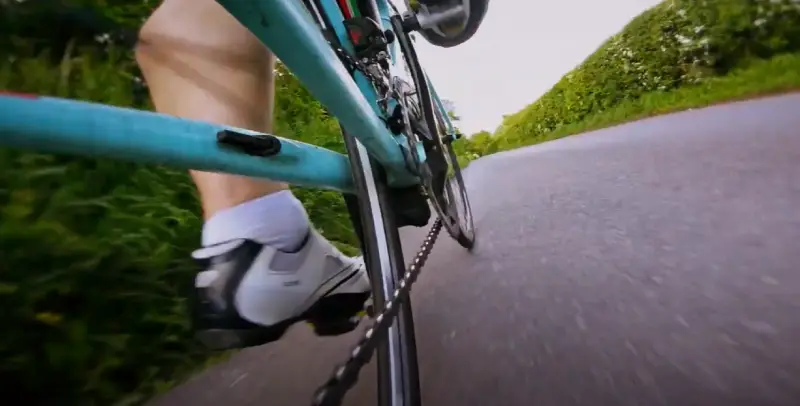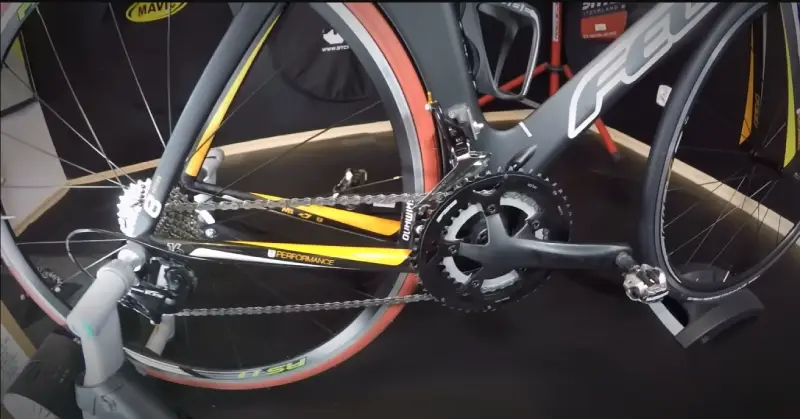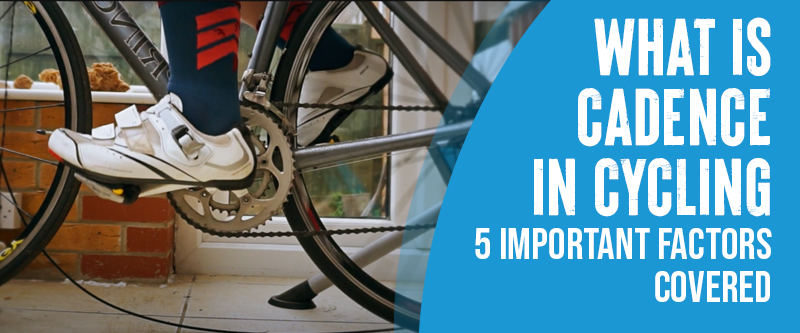Cycling with a low cadence is perfect for building strength. The low RPMs set the stage for pedaling with high torque, meaning high force. This increased torque demands more muscle fiber activation to turn the cranks, making it an excellent method for strength training.
Cadence in cycling refers to the rate at which a cyclist pedals or turns the pedals, measured in revolutions per minute (RPM).
It represents the number of rotations the bicycle crank experiences in a minute and is crucial for efficiency and performance. Gearing influences cadence and directly impacts a cyclist’s speed and effort output.
In this blog, we will explore the significance of cadence, factors influencing it, methods for tracking and measuring, and strategies for enhancing cycling cadence. Uncover common myths and misconceptions surrounding cadence.
What Is Cadence In Cycling: 5 Step-by-Step Guide

Cycling cadence, or pedal speed, is measured in revolutions per minute. For instance, 60 revolutions per minute (RPM) means one pedal turns 60 times a minute. Similarly, 110 RPM means one pedal completes a revolution 110 times a minute. Here is detailed information about cycling cadence.
Importance of Cadence in Cycling
Cycling cadence is essential for anyone serious about improving their riding skills. Understanding its significance can have a substantial impact on your performance and enjoyment. Let’s dive into why cadence matters and how to find the right cadence for you.
The Role of Cadence in Cycling Overall Performance
In cycling, cadence embodies the rhythm and pace at which a cyclist pedals. It’s more than just speed; it’s about the efficiency of keeping those wheels turning. Let’s delve into why mastering cadence holds such significance.
- Speed: Cycling faster is usually associated with a higher cadence. You can more effectively maintain or increase your speed by pedaling more times per minute.
- Endurance: Cadence affects how long you can ride. A steady cadence helps balance your energy levels, allowing you to ride longer without getting tired.
- Overall Performance: Good cadence improves cycling efficiency. It helps distribute effort evenly, reducing muscle fatigue and preventing injuries.
Optimal Cadence for Cyclists
Every cyclist is unique, and finding the optimal cadence depends on various factors. Here’s a general guide to help you determine the best cadence for different types of cycling:
- Road Cycling: Most cyclists maintain an optimal cadence between 80 and 100 RPM. This balance helps them maintain speed and endurance over long distances.
- Mountain Biking: Mountain bikers often face tough terrain and may have a lower cadence of around 60-80 RPM. This helps manage power and control on uneven grounds.
- Track Cycling: Track cyclists, who race on smooth, circular tracks, tend to have a high cadence of 90-110 RPM. This high cadence allows quick acceleration and maintains high speeds.
- Recreational Cycling: A comfortable cadence between 60 and 80 RPM is usually sufficient for casual riders. The key is to find a rhythm that feels natural and enjoyable.
Knowing why cadence matters and finding your optimal cadence can make your cycling experience more efficient and enjoyable.
Factors Affecting Cycling Cadence
Cycling cadence isn’t just about how fast you pedal. Several factors can influence your cadence, making it essential to understand what these are and how they affect your ride. Let’s break down the main factors:
Physiological Factors: Muscle Composition and Cardiovascular Fitness
Your body’s physical makeup plays a big role in your cycling cadence.
- Muscle Composition: Different muscles work when you pedal. Some people have more fast-twitch muscle fibers that help with quick, powerful movements, while others have more slow-twitch fibers for endurance. This affects how fast you can comfortably pedal.
- Cardiovascular Fitness: Your heart and lungs must be strong enough to support a higher cadence. The better your cardiovascular fitness, the easier to maintain a faster pedal rate without quickly getting tired.
Biomechanical Influences: Bicycle Fit and Pedaling Technique
How you sit on your bike and pedal also affects your cadence.
- Bike Fit: Pedaling can be harder if your bike needs to be adjusted properly. A good bike fit means your seat height, handlebar position, and pedal setup are all right. Maintaining a steady cadence is easier this way.
- Pedaling Technique: Good technique means you’re using your muscles efficiently. Practicing smooth and even pedaling can help you keep a higher cadence without wasting energy.
External Conditions: Terrain, Weather, and Gear Selection
Outside factors can also change your cadence.
- Terrain: Riding uphill usually lowers your cadence because it’s harder work. Downhill, you can pedal faster with less effort.
- Weather: Windy conditions can slow or speed you up, affecting your cadence. Riding into the wind might make you pedal slower, while a tailwind can help you go faster.
- Gear Selection: Selecting the appropriate gear is crucial. Lower gears make pedaling easier, but you may need higher gears for speed. Learning to shift gears smoothly helps maintain a good cadence.
Measuring and Tracking Cycling Cadence
![]()
Measuring and tracking your cadence is essential to get the most out of your cycling. Knowing your pedaling rate can help you improve your speed, endurance, and overall performance. Here’s how you can do it:
Tools for Measuring Cadence
There are several tools you can use to measure your cycling cadence.
- Cadence Sensors: These are small devices that attach to your bike. They count each pedal stroke and send the data to a display on your handlebars, giving you real-time feedback on your cadence.
- Bike Computers: Many modern bike computers come with built-in cadence sensors or can be paired with external ones. They track your cadence and provide other useful data like speed, distance, and heart rate.
- Smartphone Apps: Various apps can track your cadence when connected to a compatible sensor. They often offer additional features like route mapping, workout tracking, and performance analysis.
Capacities and What They Mean for Your Ride
Once you have your cadence data, it’s important to understand what it means.
- Average Cadence: The average number of pedal strokes per minute during your ride. Most cyclists aim for between 80 and
100 RPM. - Peak Cadence: This is the highest cadence you reached during your ride. It shows your ability to pedal quickly when needed, like during sprints or fast descents.
- Cadence Zones: Some tools allow you to set different cadence zones, similar to heart rate zones. Staying within your target cadence zone helps you ride more efficiently and avoid fatigue.
Improving Your Cycling Cadence
Improving your cycling cadence can improve performance and make your ride more enjoyable. Here are some practical ways to enhance your pedaling rate.
Training Techniques to Improve Cadence Efficiency
Practice makes perfect, and these exercises can help you pedal more efficiently.
- High Cadence Drills: Try riding at a higher cadence than usual for short bursts. For example, pedal at 100-110 RPM for 1-2 minutes, then return to your normal pace. Repeat this several times during your ride.
- Single Leg Drills: Pedal with one leg at a time while keeping the other leg off the pedal. This helps improve your pedal stroke and muscle coordination. Give each leg 30 seconds to a minute.
- Spin-Ups: Gradually increase your cadence over a set period without shifting gears. Start at a comfortable cadence and keep growing by 5 RPM every minute until you reach your maximum sustainable cadence.
Cadence Optimization Strategies
Keeping a steady cadence can make your ride smoother and more efficient. Here’s how to do it:
- Gear Selection: Use your gears to maintain a steady cadence, especially on hills. Shift to lower gears when climbing to keep your cadence from dropping too much. Shift to higher gears when descending or on flat terrain to avoid spinning too fast.
- Pacing: Learn to pace yourself to avoid burning out. A steady effort helps you maintain a consistent cadence, which is crucial for long rides.
- Monitoring: Use cadence sensors or bike computers to keep track of your cadence in real time. These tools help you stay within your target range and adjust as needed.
- Core Strength: Strong core muscles help stabilize your body, making it easier to pedal smoothly. Incorporate core exercises like planks and bridges into your routine.
Common Cadence Myths and Misconceptions

There are many myths and misconceptions about cycling cadence. When you know the truth, you will be able to improve your performance and avoid mistakes. Let’s dive into some common myths and set the record straight.
Debunking Cadence Myths: Separating Fact from Fiction in Cadence Beliefs
Several widespread beliefs about cadence aren’t true. Here are a few myths and the facts behind them:
- Higher Cadence Is Always Better: Many think pedaling faster is the best choice. Fact: The best cadence varies for each person. What works for one cyclist might not work for another.
- Professional Cyclists Always Use High Cadence: It’s easy to assume that all top cyclists pedal quickly. The fact is that professional cyclists use different cadences depending on the terrain, fitness, and strategy.
- Low Cadence Means Poor Fitness: Some believe a lower cadence indicates a lack of fitness. Fact: A lower cadence can be efficient for certain types of riding, like mountain biking or time trials.
Evaluating Common Recommendations and Their Validity
Cadence advice is often passed around, but knowing which tips are helpful is important. Here’s a closer look at some common recommendations:
- Stick to a Cadence of 90 RPM: Many cyclists aim for this number. It’s a good starting point, but it might not suit everyone. Test different cadences to find what feels best for you.
- Train with High-Cadence Drills Only: While high-cadence drills are useful, don’t neglect other aspects of training, like strength and endurance. Balance your workouts for the best results.
- Use Gears to Maintain Cadence: This is solid advice. Shifting gears helps keep your pedaling rate steady, especially on varied terrain.
Conclusion
Mastering your cycling cadence is a journey that entails understanding your body, bike, and surroundings. We’ve delved into crucial topics like the significance of cadence, its physiological and biomechanical impacts, and ways to measure and monitor it.
Amidst the numbers and data of tracking, remember the ultimate aim is to boost your cycling performance and efficiency. So, don’t just absorb information. Gear up, ride out, and weave cadence training into your routine. The true test of your cycling cadence prowess unfolds on the open road.
FAQs
How Does Age Affect Cadence?
As we age, running cadence increases while step length decreases. Older runners typically exhibit a higher cadence and shorter step length than younger runners. This change in running gait is a common adaptation seen with aging.


